Hurricane Mk.IIc (x4)
and
Hurricane
Mk.IV
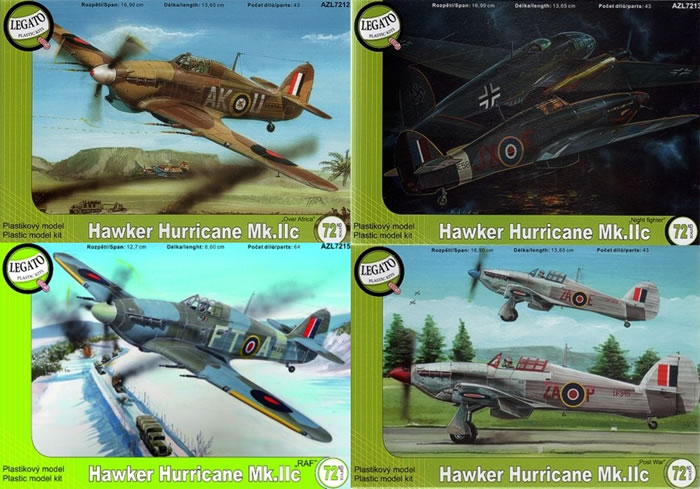
A.Z. Model, 1/72 scale
S u m m a r y : |
Catalogue Number: |
AZL7212 Hurricane Mk.IIc “Over Africa”
AZL7213 Hurricane Mk.IIc “Night Fighter”
AZL7215 Hurricane Mk.IIc “RAF”
AZL7216 Hurricane Mk.IIc “Post War”
AZ7389 Hurricane Mk.IV “Special” |
Scale: |
1/72 |
Contents & Media: |
Mk.IIc: 57 grey styrene and 3 clear styrene parts plus 2 decal options each.
Mk.IV: 42 grey styrene, 1 clear styrene, and 13 green resin parts plus 3 decal options. |
Price: |
Available from these on-line stockists: |
Stockist |
Hurricane Mk.IIC |
Hurricane Mk.IV |
Hannants |
£10.25 |
£14.75 |
Modelimex |
€10.00 |
€17.50 |
West Coast Hobbys |
Not Listed |
Can$23.00 |
Hobby Link Japan |
Not Listed |
¥1920 |
Click here for currency conversion. |
Review Type: |
First Look |
Advantages: |
Good outline shape (the same as Hasegawa’s) and generally nice surface detail with better fabric areas than most other Hurricane kits. A choice of cannon style with the Mk.IIc kits is good to have. The seat has a harness moulded integrally. The Mk.IIc kit correctly portrays the wheel well structure, and is the best example of this feature of any Hurricane kit in this scale. |
Disadvantages: |
Some mould damage evident and a lot of annoying flash. The canopy has slightly thick framing and is a bit mediocre. The Mk.IV lacks landing lights in the leading edges of the wings. |
Conclusion: |
Mk.IIc: Legato’s Mk.IIc kits are probably the best available in 1/72-scale for now, in theory at least. Their edge over the other four modern and readily available alternatives is to have as good a shape as Hasegawa’s without the spinner problem, but with better fabric rendition, accurate and well-detailed wheel wells, a choice of cannon barrel style and the best cockpit detail. Despite these strengths, it is close run thing as the long-run alternatives all build very easily whereas the Legato kits need a lot cleaning up. The price and good fit of the competition may tempt some away from Legato’s strengths.
Mk.IV: AZ Model is really the only game in town when it comes to kits of this version. It is largely the same as the Legato Mk.IIc, but sadly not quite as good despite being from the same brand stable, being let down by average wheel wells and no landing lights. It is less vulnerable than Legato’s Mk.IIc because there is only very sparse competition for this version.
I am happy to recommend both of these kits as theoretically the best Hurricane Mk.IIc & IV kits in their scale. They are generally a modest improvement on what has gone before in terms of accuracy and detail, but there is a lot of flash and some mould damage issues that will be tiresome to remedy. Some may favour the hassle-free builds that the still reasonable long-run Hurricane kits offer, in some cases at half the price. |
Reviewed by
Mark Davies

HyperScale is proudly sponsored by
Squadron.com
The Hawker Hurricane needs no introduction because most aviation enthusiasts and modellers will at least know its outline history. I will therefore make only brief mention of some features applicable to the Hurricanes that are the subjects of this first look review.
The Hurricane Mk.IIc is instantly recognizable for its four aggressively protruding 20-mm cannon, but it was not the first operational Hurricane to use this weapons fit, the Sea Hurricane Mk.Ic was. The Mk.IIc was however more powerful and had far better performance using the same heavy armament. Production commenced in May 1941, and it was to become the most produced version of the Hurricane.
The Mk.IIc packed a more powerful punch than most of its contemporaries, but it was also slower than many of them. It served well throughout WW2, although by late 1944 its frontline service was mainly in the Far East. It fulfilled diverse roles including night-fighter, intruder, photoreconnaissance, and day fighter (when outside of Western Europe); but it was ground attack that increasingly became its forte. Some also had arrestor hook conversions to become Sea Hurricane Mk.IIc’s, but these retained RAF radios and other equipment and were not as navalised as previous “true” Sea Hurricanes. There were some fully navalised late production Sea Hurricane Mk.IIc’s, but few saw shipboard service.
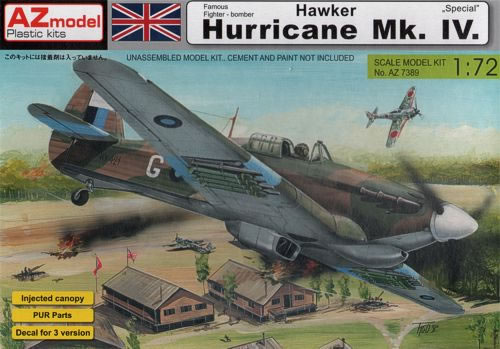
Logically enough the next Hurricane version was the Mk.IId, which was the first production type armed with two 40 mm Vickers Type S cannon and two .303” machine guns for sighting purposes. This version initially had the same armour as other MK II’s, but added 348-lbs of additional protection later in the production run. Meanwhile work proceeded on a dedicated ground attack variant using a universal wing that could accept several armament options. These included four 20-mm cannon, two 40-mm cannon and two .303” machine guns, and the ability to carry various sized bombs, drop-tanks or rocket projectiles under the wing. The result was the Mk.IIe, but it was renamed the Mk.IV before its service introduction. It had a more powerful 1,620-hp Merlin 27 engine, an armoured radiator, additional engine armour, and the universal wing. Production commenced in April 1943 and it was still in frontline service in the Balkans and Far East at the war’s end. It was the last production version, but not the last Hurricane produced, as this honour went to a Mk.IIc in the summer of 1944.
Previous 1/72 Hurricane Mk.IIc & Mk.IV Kits
Numerous 1/72 Hurricane Mk.IIc kits have kept modellers busy over the years. I have named the original mould manufacturers first, followed by their re-box brands in brackets if applicable: Kelkraft, Lotnia (Farmtex), Ikko (AHM & Arri), Frog (Bienengraber, Hema, Humbrol, Milion Plamo, Minix, Minicraft, Novo, Plasty, Roly Toys, Tashigrushkam, Remus), Matchbox (AMT), Heller (SMER), Academy, Hasegawa, Revell and Airfix.
No shortage then of Mk.IIc’s, but most 1/72-scale modellers would probably select from Hasegawa, Revell, Academy or Airfix if buying a new kit these days. None of these brands’ Mk.IIc Kits is so good that they deny room for a new kit to have a chance in the market, so please, try to stifle any groans about not needing another Hurricane Mk.IIc in the one true scale - Thank you.
There have been relatively few 1/72 Hurricane Mk.IV kits. Airfix’s purportedly enabled you to build a Mk.Ia, IIa and IV from the same kit, but lacked the Mk.IV’s armoured radiator and had the same engine cowl for all versions! (Airfix Corp, Airfix Craftmaster and Plasty all re-boxed this best forgotten release). Hasegawa released a MK.IV based on their Mk.IIc with a suitable radiator, Vokes filter and weapons parts. I have no doubt that this is probably a good kit, but sadly, I think it is also very rare. The slightly more readily available SMER Mk.IV is a re-box of Heller’s Mk.IIc with additional parts. It is therefore quite apparent that we are overdue for a modern and readily available Mk.IV kit.
Overview
AZ Models emerged a few years ago as a brand from Legato, who had until then produced resin kits (although their resin kit production appears to have ceased around the same time). The AZ brand stable now includes AZ Model, AZ-Model Basic, Silver AZ Edition, AZ Airport, Admiral, and now a “resurrected” Legato re-applied to injection-moulded kits. AZ Airport aside, I have never been able to fathom AZ Model’s branding logic, if indeed there is any. The type and quality of kits across the brand names is generally very similar, the subjects covered by all brands are quite varied, and it is clear that some tool sharing within the ranges also occurs. So it comes as no surprise that the new Legato Hurricane Mk.IIc kits share many parts in common with the AZ Model Hurricane MK.IV (which shares its sprues with their Hurricane Mk.IId and Mk.V kits).
The kits reviewed here are typical of AZ Model family, being limited-run injected styrene kits with clear styrene canopies. The quality of moulding, sprue gate size and so on is generally similar to Special Hobby’s for the sake of comparison to a possibly better-known brand. The Mk.IV has some resin components, which is sometimes a feature of other AZ Model, Admiral and AZ Silver kits as well.
A typically Czech end-opening box contains a surprise within; this being what is in effect the bottom-half of a top-opening box. It serves as a handy drawer for the kit components, and leaves the outer box free to look at the painting and markings guide on its reverse side. It also lends some extra rigidity to the closed box and so reduces the chances of crushing. A re-sealable cellophane bag contains the kit parts and instructions.
The Contents
The folded A-4 sized instructions contain a parts map and diagrammatic assembly stages as you would expect. However, going by today’s standards I would describe them as mediocre in appearance. They are adequate for their purpose, which with a 1/72-scale Hurricane kit is simple enough, but simply look cheap. I do not suppose it matters a great deal, but they are out of step with the standards set by the remainder of the package. Paint call-outs use generic names and Humbrol paint numbers. Written instructions are in English and Czech, and used sparingly.
The kit parts come moulded in a matt-finish plastic on one clear and two grey sprues with reasonably fine gates. There is flash on most parts. All of the Mk.IIc kits reviewed share exactly the same sprues, whereas the Mk IV has a different sprue layout despite sharing some parts in common with the Mk.IIc kits.
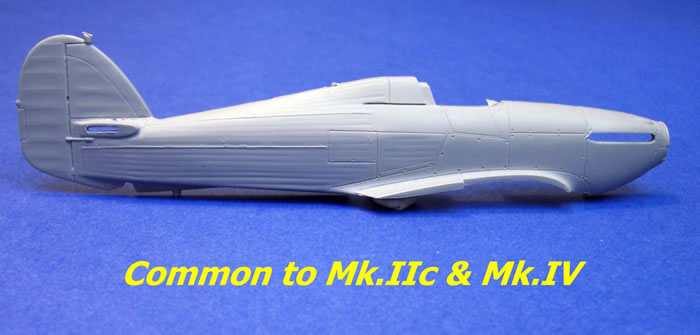
The parts are typically limited run in that they lack locating lugs, and the moulding of some small details looks a bit soft in places.
The Airframe
Surface detail is generally good with delicate recessed panel lines, raised inboard wing strengthening strips and restrained fabric covered areas. Fabric effect is an area several Hurricane kits are let down by, and the AZ/Legato fuselage fabric is far from perfect. It is scalloped rather than looking like a series of almost flat strips with well defined edges (see accompanying image), but it does appear less exaggerated than on several other kits.
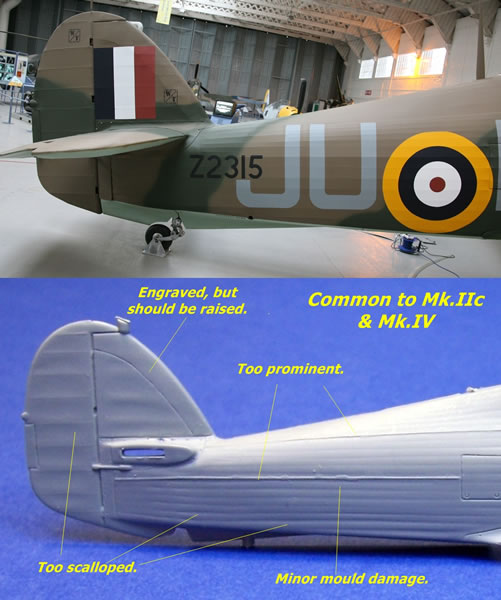
Despite this, they have exaggerated two very slightly more defined stringers on the real Hurricane, and these will need sanding back to appear far less prominent. This should also address some slight mould damage affecting one these raised lines. There is a curved line incorrectly engraved on the fin. This should be a slightly raised line caused by the fin’s leading edge structure under the fabric. I suggest laying some stretched sprue in the engraved line and sanding it down carefully.
The clear one-piece canopy is adequate for the job given that little of the cockpit detail will be visible anyway. However, it is not as clear as some other brands, the framing is a bit thick and I could see signs of very slight mould damage. It is useable as is, but I would be tempted to replace with a Falcon vacform or sand the framing off, polish it, and use painted decal strips for the framing. The Mk.IIC also has two clear landing light covers, something the Mk.IV lacks unfortunately.
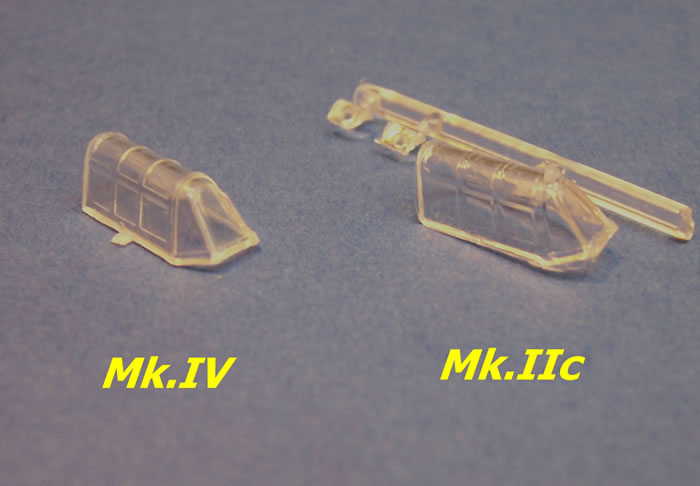
There is a major difference in the wheel well structure between the Mk.IIc & IV kits, although I believe this is not the case with real Hurricanes, as I think that the well remained essentially unchanged across all versions. The Mk.IV kit shares its sprues with the Mk.IId and Mk.V boxings that were first released in various boxings about a year ago. These all have a fully enclosed wheel wells with walls that incorrectly follow the curved outline of the well’s cutout in the wing’s undersurface (the Hasegawa, Academy and Revell kits are similar in this respect). The Mk.IIc kits however have a far more authentic wheel-well interior formed by a box whose walls are some distance from the cutout edges (as is the new Airfix Mk.IIc’s).

Resin caters for the Mk.IV’s armoured radiator housing, as it does for the seat, which is strange, as this item is otherwise identical to the Mk.IIc’s plastic seat, although the resin seat reveals the harness detail better. The other resin parts included with the Mk.IV are a carburetor intake and eight rocket projectiles (RP’s) with their launch rails.

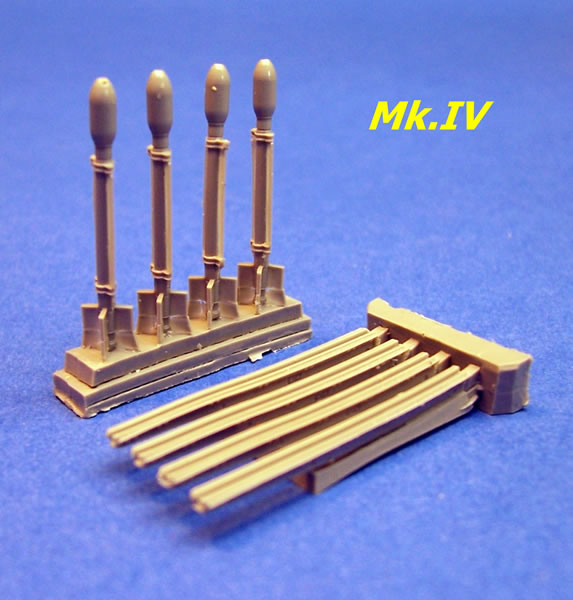
Cockpit detail is generally quite good for a subject with a closed canopy. There is sidewall detail moulded inside the fuselage halves, a rear bulkhead and floor with heal-boards. The Hurricane lacked a solid floor but this compromise is acceptable I feel. The Mk.IIc’s instrument panel looks quite good complete with its compass repeater, yet the Mk.IV’s lacks this feature. There are rudder pedals that will be hard to see, and a reasonable representation of the control column that will benefit from a good clean up. The seat with its integrally moulded harness and a nicely detailed gun-sight complete the Mk.IIc’s cockpit, but a sight is not included with the Mk.IV!
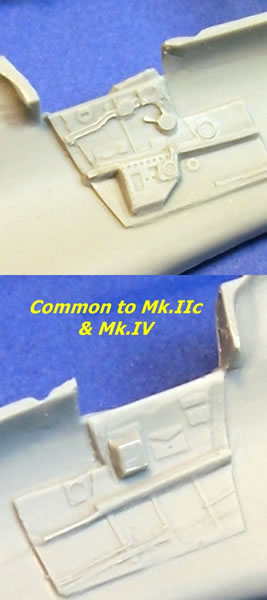
Airframe construction for both marks is conventional and essentially the same. The trailing edges of wings are reasonably fine and conform to the general limits of short-run injection moulding, so some will wish to refine these further. There is a Vokes filter with both kits, which is applicable to some kit colour schemes. As mentioned already, the radiator housings differ in shape; the Mk.IV’s is resin whilst the Mk.IIc’s is styrene. Both use styrene matrix faces, although of different shapes, and include the circular oil cooler in the centre.
Nicely detailed wheel wells are a feature of both kits, but the Mk.IIc has the more accurate example as mentioned earlier because its walls do not follow and join the full outline of the opening. The Mk.IIc instructions advise to shorten the undercarriage legs by 2-mm because of the difference in depth of its wheel well inserts. The Mk.IV’s less accurate wheel well reflects a similar approach adopted by several other brands of Hurricane kit. The undercarriage doors look okay and the main wheels have weighted tyres. The wheel rims on the Mk.IV sprue looked a bit rough, I think possibly due to mould damage.
Remaining items include two 40-gallon drop tanks, exhausts with separate blanking plates to fix behind their fuselage opening, and an under-wing pitot, antenna mast, and of course the canopy. These parts are common to both kits.
The Mk.IIc has four very prominent 20-mm cannon, and the kit provides examples of both style of Hispano with their different recoil spring locations. This is a nice touch allowing the builder some flexibility to complete a variety of colour schemes. The cannons look reasonable, but cleaning the flash from the springs will be a nuisance I suspect. Also applicable to the intruder and night-fighter options are two exhaust glare shields to fit to the fuselage sides ahead and below the cockpit. The thickness of these is well over scale and they will need thinning or replacement with suitable plastic card pieces. The instructions are a little vague regarding their exact location.
The Mk.IV boxing reviewed here focuses on RP-armed examples. You can mount the RP’s under both wings, or asymmetrically with RP’s under one wing only and a 40-gallon tank under the other (although the instructions do not mention this). The RP’s are better cast than first appearances suggest because easily removed mould flash between their stirrups makes them appear chunky. Cleaned up they should look quite good because they are finer than injection moulding could produce. The rails on my sample need some gentle straightening in warm water, but otherwise look okay. There are some small and unwanted little lumps on the blast plates between the rails, but these should be easy to remove.
The instructions do not address gun armament, and the wing has no blast holes in the wing’s leading edge, although the spent case and link ejection chutes are on the wing’s underside. Mk.IV’s were supplied from the factory with two .303 machineguns as a standard fit in what would otherwise be the outboard 20-mm cannon bay. Possibly these were removed when rockets were used, but I am inclined to think not, and recommend blast holes be drilled in the wing’s leading edges. The kit has 40-mm cannons intended for use with other boxings that could replace the rockets, but check references for markings and remember to drill the holes for the .303 machineguns if you do build a tank-buster.
AZ Model’s Mk.IV preceded Legato’s Mk.IIc, so it is good they have improved the wheel wells, instrument panel and landing lights on the later kit. It is a pity they did not include the improvements with their Mk.IId, IV & V kits retrospectively, but I can understand the economics of why they did not. Perhaps when the Mk.IId/IV/V mould wears out they will.
I doubt that assembly of the AZ/Legato kits will run quite as smoothly as would be the case for the Hasegawa, Academy, Revell, or Airfix kits. This said however, I do not think that there will be any real difficulties either. Modern limited run kits like these demand more cleaning up prep than their mainstream brand equivalents, and possibly a bit more fit adjustment, but generally, that is about it. I can see nothing to suggest that this will not be the case with the kits reviewed here.
Colours & Markings
All of the Legato Mk.IIc kits reviewed here are the same other than the two markings options provided with each boxing. Each kit’s markings conform to a broad theme as is apparent from the box sub-titles such as “Over Africa”, “Night Fighter”, “Post War” etc.
This approach of offering numerous different decal options by boxing gives the end-user a wide choice of colour schemes, but I should think it may disadvantage stockists who must second-guess the market as to which to stock and in what quantities. In the short term this will be good for AZ/Legato because stockists may end up carrying more product than otherwise would be the case. However, stockists may in the longer term settle on just carrying the sure-to-sell boxings, and indent any others as they are requested by customers. This in turn may mean that end-users will wait longer to get the less popular boxings.
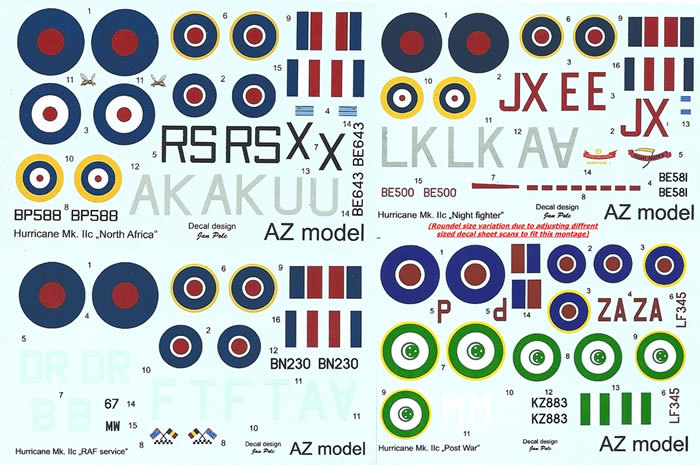
The Hurricane Mk.IIc markings options provided by box number and subtitle are:
-
BP588 / RS-X, No 33 Sqn RAF, Benina, Libya, November-December 1942. (Dark Earth & Stone over Azure Blue).
-
BE643 / AK-U, No 213 Sqn RAF, Edku, Egypt, 1942. (Dark Earth & Stone over Azure Blue with hornet motifs superimposed on fuselage roundels).
-
BE581 / JX-E, No 1 Sqn RAF, Redhill, May 1942. (Early-style intruder scheme of Dark Green & Ocean Grey over Black).
-
BE500 / LK-A, Sqn Ldr Smallwood, CO No87 Sqn RAF, Charmmy Down, 1942. (Black overall).
-
MW367 / DR-B, No 1697 Flight, Air Dispatch Letter Service, Northolt, July 1944. (Dark Green & Ocean Grey over Medium Sea Grey with invasion stripes).
-
BN230 / FT-A, Sqn Ldr Leroy Du Vivier (first Belgian to command an RAF Sqn), No 43 Sqn RAF, January 1942. (Dark Green & Ocean Grey over Medium Sea Grey).
-
LE345 / ZA-P, (Aluminum overall with late-war roundels).
-
KZ883 / M, Meteorological Flight, Royal Egyptian Air Force, Almaza, Egypt 1946. (Unarmed Ex-RAF, faded Dark Earth & Stone over Azure Blue with additional Dark Brown patches).
The Mk.IV boxing under review here is not the first by AZ Model (there are two others: a 40-mm gun option and SEAC boxing, and of course there is the very similar Mk.V).
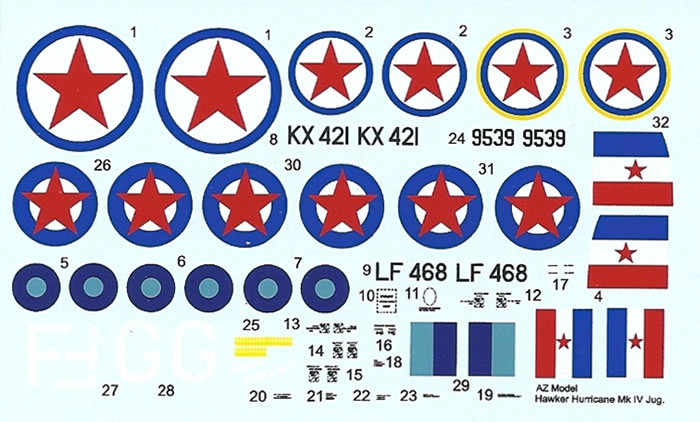
The kit reviewed here features these three options:
-
9539, Yugoslav Air Force, 1946. (Aluminium overall).
-
KX421 / G, RAF, SEAC, Burma, 1945. (Dark Green & Dark Earth over Medium Sea Grey with Light Blue recognition Band and White fin band).
-
LF468 / F, Yugoslav Air Force, 1945. (Dark Green & Ocean Grey over Medium Sea Grey).
The painting and markings guides are on the reverse face of the kit boxes. They provide colour call-outs using Humbrol’s colour names and numbers. The decals look to be good quality and registration is sharp.
Accuracy & Comparisons
Both the Mk.IIc & IV kits look good in terms of general accuracy when compared to walk-arounds and in-service images. I have not made a comparison to plans, as I have no assurances regarding the accuracy of those to which I have access. I do however think it useful to compare the review kits to those that have gone before and remain their rivals.
Because there are so many Hurricane in this glorious scale of 1/72nd, I shall restrict the other contenders to those most likely to be alternative purchases. Some may disagree, but based on modernity and availability I think these are Hasegawa, Revell, Academy (mid to late 1990’s releases) and Airfix (from 2011). I will restrict my assessments to the basics rather than every little pro or con, and I will ignore decals, optional parts, instructions, packaging etc. I will mention some dimensional or shape issues described in kit reviews I have read and respect, or faults that are based on widely held opinions within 1/72nd aircraft modelling circles:
-
Hasegawa: Crisp moulding, fine panel lines, good fit, good shape, scale 2” under-length in the fuel tank area between the cockpit and engine (I think most will accept this roughly 0.7mm shortfall), dreadful spinner shape, saggy fabric effect, basic cockpit, compromised wheel well with the walls following the cutout. Toning down the fabric effect is easy enough and a replacement spinner or prop is available. Yes, it carries a price premium, but it is still a good kit overall.
-
Revell: Crisp moulding, fine panel lines, good fit, reasonable shape, scale 3” oversize in wing chord, cockpit opening has no portion of the “doghouse” under the canopy, uninspired prop blades, exaggerated fabric effect (less-so than Hasegawa), basic cockpit, compromised wheel well with walls following cutout. Wing takes more work to fix than Hasegawa’s fuselage length issue (most will probably ignore it), good clear and thin canopy with the option of having it open. A generally good kit overall and well priced.
-
Academy: Crisp moulding, fine panel lines, reasonable fabric effect, good cockpit detail, good fit, generally reasonable shape except for the too narrow cowl that needs an insert to widen, and which will require a spinner change too. The skinny canopy also needs replacement. It has a well detailed but compromised wheel well with walls following cutout. Well priced (cheapest of the bunch), the fixes are quite simple, and I am inclined to think that it is often written off too quickly without pause to think how its main fault can be easily overcome.
-
Airfix: Nice fabric effect (but fails to include panels by the rear wing-root), mould damage on the starboard fuselage ahead of the cockpit, deep panel lines look terrible, wrong shape tail-plane, somewhat spurious panel lines on the fuselage, basic cockpit, pathetically undersized propeller, windscreen looks a little too far forward, generally realistic wheel-well. Well priced, but frankly too toy-like and inaccurate to be worthy of serious consideration in my view. Buy Academy or Revell if price is an issue (and for that matter buy Heller or SMER before this Airfix offering).
So how do the AZ/Legato kits stack up compared to these four? Well for a start, I will simply write Airfix off from any comparison. The price saving is just not worth it. It soon became clear to me that the AZ/Legato outlines conform exactly to Hasegawa’s, sufficient for me to bet politely that Hasegawa’s Hurricane Mk.IIc had a “major influence” on the mastering of the review kits. Given that limited run kit moulds are usually metal-sprayed resin tools made by casting from a positive master, it seems that an existing kit whose shape is generally good might make a tempting start-point.
The AZ Model and Legato kits are, like Hasegawa’s, a tad short between the windscreen and engine. This will be harder to fix than with Hasegawa because the Hasegawa kit has a separate engine cowl, meaning the break to accept a scale 2” plastic shim is already there. To fix the AZ/Legato kits will be harder as the cut behind the engine needs to also curve around the wing root. I think most builders will live with the roughly 0.7mm shortfall. Any possible Hasegawa influence did not extend to the spinner fortunately, as this looks okay.
The AZ/Legato kits are better, to varying degrees, in terms of their fabric effect on the fuselage and tail than the comparison brands described earlier. Although not perfect, the Legato Mk.IIc cockpit is the more accurate and better detailed than these brands as well. Despite some good points, the not so good MK.IV cockpit falls a little short due to a lack of gun-sight and compass. A compromised wheel-well affects the Mk IV as it is similar those found in the Hasegawa, Revell and Academy kits. The Mk.IIc’s is essentially accurate, and superior to Airfix’s accurate but simplified rendition. Flash aside, the biggest annoyance of the review kits is probably the absence of leading-edge landing lights in the Mk IV’s wing.
In my view the Legato/AZ have an overall edge in accuracy, especially the MkII.c because of its good wheel wells, whilst the choice of cannon styles is a nice touch. Cockpit detail is also the best of the bunch, but the canopy is not very good. Surface detail has the edge over the others to varying degrees, largely due to superior, albeit still flawed, representation of the fabric-covered areas. Therefore, the best out of the box Mk.IIc is I think Legato’s kit. When it comes to a Mk.IV then AZ Model is really the only game in town short of converting another brand Mk.IIc kit (or tracking down the rare Hasegawa Mk.IV.
I had trouble finding current Hasegawa Hurricane pricing, but this is likely to be similar or more than Legato’s for the Mk.IIc, whilst Revell and Academy are about half this cost (Airfix is also about half Legato’s price, but would be a waste of money regardless). I think many could live with Revell’s Hurricane as is, and the Academy kit is a good bet if you shim the forward fuselage, have a Falcon canopy and a larger diameter spinner to hand. Both will be easier to build than Legato’s Mk.IIc. For similar or money to Legato you can have the same outline shape from Hasegawa, but fix the spinner! Again, this will be an easier build. A conversion to a Mk.IVof any of the comparison brand kits is possible, but the cost of after-market 40-mm cannons or rockets, and making an armoured radiator, probably makes AZ Model’s kit the most competitive, but some will have spare RP’s lying around and 3D do aftermarket Vickers guns – so maybe not.
None of the readily available and mainstream 1/72-scale Hurricane Mk.IIc kits is sufficiently good to suggest there is no room for another one in the marketplace, as the four main comparison brands used here all have their weaknesses. In the case of the Hurricane Mk.IV it could be said that we are long overdue a decent kit in the one true scale. So on both counts the Legato/AZ Model releases reviewed here are most welcome. They are all typical of modern Czech short-run injected kits in that they have fine surface detail, injected canopies, good interior detail, and good decals. Their parts will need a lot of cleaning up prior to assembly. With the cleanup finished, the chances are they will be a little trickier to build than modern long-run kits.
If generally good accuracy combined with authentic surface detail and a good cockpit are your priorities, then Legato’s Mk.IIc will probably be a winner for you. However, if you throw price and buildability into the mix then you may find yourself looking at Revell or Academy. The wrong spinner shape, overstated fabric effect, less cockpit detail, the same outline and no price advantage make Hasegawa’s Mk.IIc less competitive against Legato’s, but it will be far easier and quicker to build (As an aside, I personally favour it more than my comments might suggest because it is simply a nice kit) .
The Mk.IV is in a class of its own unless you wish to convert an existing Mk.IIc, so the AZ Model kit has little competition despite the annoyance of no landing lights in its wing leading edge.
As things stand, the Legato and AZ Model kits reviewed here have a theoretical advantage over the readily available alternatives in my view, but I accept that a slightly different weighting of factors could easily see any of my comparison brands, bar Airfix, take centre stage. After all the better cockpit detail cannot really be seen, exaggerated fabric effect of some other brands can be easily fixed, inaccuracy issues can be accepted or remedied, and above all, the other three comparison brands all build very easily. This last factor is an important one for many modellers. Furthermore, there is price, which is always an important arbiter and one that favors three of the four alternatives used.
I am happy to recommend both of these kits as theoretically the best Hurricane Mk.IIc & IV kits in their scale. They are a modest improvement on what has gone before in terms of accuracy and detail, but there is a lot of tiresome flash and some mould damage issues to live with. I confess I am not totally convinced that they are worth the hassle or price given the readily available alternatives (and I have built many limited run kits). The Legato and AZ Hurricanes may just be sidelined by the hassle-free and still reasonably accurate long-run kit alternatives that are, in some cases, around half the price.
Thanks to AZ Model for these review samples.
Review Text & Images Copyright © 2012 by Mark Davies
Page Created 25 May, 2012
Last updated
25 May, 2012
Back to HyperScale Main Page

|
